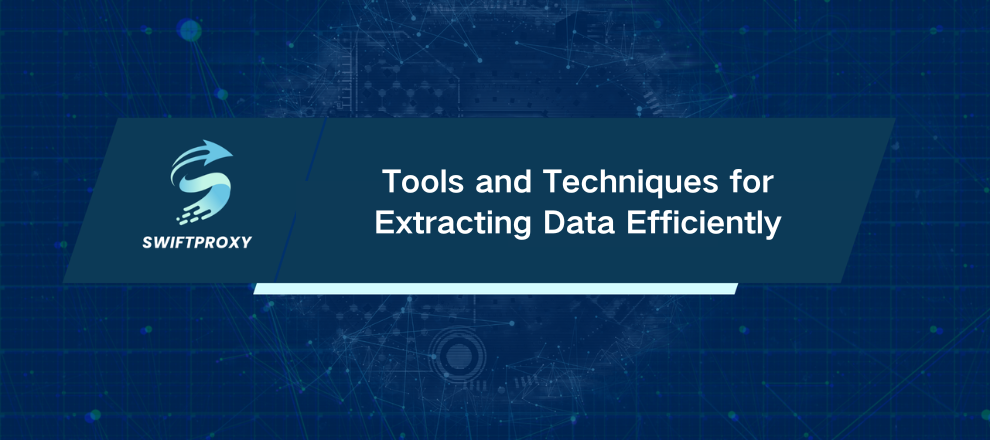Tools and Techniques for Extracting Data Efficiently
Imagine being able to pull any piece of data from the web, instantly and reliably. Prices, reviews, competitor moves, SEO insights—anything you need, all at your fingertips. This isn’t magic. It’s smart data extraction, and mastering it can transform the way you makbuyonge decisions. Whether you’re a developer, marketer, or business strategist, understanding how to systematically gather web data is a skill that delivers real competitive advantage. Let’s break down the methods, tools, and best practices to make web scraping both efficient and safe.

Introduction to Data Extraction
Data extraction is more than just grabbing information—it's about turning raw web content into actionable insights. Done right, it empowers you to:
Monitor social media performance and audience engagement
Track competitor pricing strategies
Generate leads and build prospect lists
Aggregate product reviews and customer feedback
Analyze SEO metrics for smarter marketing campaigns
Stay on top of breaking news and brand mentions
Automating this process saves time, reduces errors, and unlocks data that can guide strategic decisions across your organization.
Methods to Extract Data from Websites
There are three main approaches to web data extraction, each suited for different skill sets and business needs:
1. Coding with Programming Languages
For technically proficient users, writing custom scripts offers complete control over the extraction process.
Step-by-step approach:
Identify the Data Source Format
Check if the website has an API, RSS feed, or uses a static or dynamic page.
Choose the Right Tools
APIs and feeds: cURL, regex, or JSON parsers
Dynamic content: Headless browsers like Puppeteer (NodeJS) or Selenium (Python)
Implement Scraping Logic
Send requests, handle responses, and parse the data you need.
Handle JavaScript-Rendered Content
Many modern sites load content dynamically. Headless browsers let you scrape it reliably.
2. Using No-Code Tools and Applications
Not everyone writes code. That's where no-code scraping tools shine. They allow anyone to pull data without touching a line of code.
Top no-code tools:
Data Miner: Chrome extension for quick site-specific scraping
Web Scraper: Browser-based tool for building customized scrapers
Data Scraper: Intuitive, drag-and-drop interface for beginners
Apify: Advanced platform with ready-to-use scraping applications
ScreamingFrog: SEO-focused, perfect for analyzing site structures
Most tools come with templates for popular websites, speeding up setup and reducing errors.
3. Outsourcing to Third-Party Services
Sometimes, the smartest move is to let experts handle the heavy lifting. Outsourcing to professional scraping services or data brokers can save time and give you access to:
Comprehensive datasets, including historical information
Continuous data updates, keeping your insights fresh
Custom solutions, tailored to your unique requirements
This approach frees your team to focus on analyzing and using data, rather than building and maintaining scrapers.
Choosing the Right Method
Selecting a method depends on your technical skill, budget, and data needs.
Technical expertise: Coders can create custom scripts; non-technical users may prefer no-code solutions.
Budget: In-house coding is cost-effective; outsourcing adds service fees but reduces workload.
Data complexity: Dynamic sites or large datasets may require more robust solutions.
Flexibility: Consider future growth and how often you'll need to update data.
Assessing these factors ensures you pick a method that is both efficient and sustainable.
Avoiding Detection and Bans
Websites fight automated scraping. Avoid detection with these tactics:
Use proxies: Rotate IP addresses to mimic genuine traffic
Obey Robots.txt: Follow site crawling guidelines
Implement rate limits: Avoid sending too many requests too quickly
Randomize request patterns: Simulate human browsing behavior
These strategies reduce the risk of getting blocked while maintaining smooth data collection.
Using Proxies for Secure Extraction
Proxies are important for safe and scalable web scraping. Services like Swiftproxy provide:
IP rotation: Each request uses a different IP for anonymity
Stable uptime: Consistent access to target sites
Worldwide reach: Access websites worldwide
Affordable pricing: Fit for any budget
Integrating proxies into your workflow ensures your scraping operations remain undetected, secure, and efficient.
Conclusion
Extracting data from any website isn't about hacking—it's about choosing the right method, using the right tools, and staying smart about anonymity. Whether you code your own scraper, leverage no-code platforms, or outsource, understanding the process and protecting your operations is critical. With the right approach, every website becomes a potential source of insight—and your business decisions become sharper, faster, and more informed.


















































